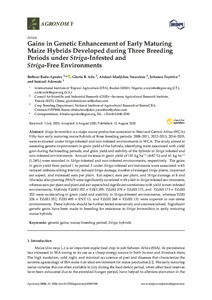| dc.contributor.author | Badu-Apraku, B. |
| dc.contributor.author | Adu, G.B. |
| dc.contributor.author | Yacoubou, A.M. |
| dc.contributor.author | Toyinbo, J. |
| dc.contributor.author | Adewale, S. |
| dc.date.accessioned | 2021-11-11T13:05:18Z |
| dc.date.available | 2021-11-11T13:05:18Z |
| dc.date.issued | 2020 |
| dc.identifier.citation | Badu-Apraku, B., Adu, G.B., Yacoubou, A.M., Toyinbo, J. & Adewale, S. (2020). Gains in genetic enhancement of early maturing maize hybrids developed during three breeding periods under striga-infested and striga-free environments. Agronomy, 10(8), 1188: 1-19. |
| dc.identifier.issn | 2073-4395 |
| dc.identifier.uri | https://hdl.handle.net/20.500.12478/7276 |
| dc.description.abstract | Striga hermonthica is a major maize production constraint in West and Central Africa (WCA). Fifty-four early maturing maize hybrids of three breeding periods: 2008–2011, 2012–2013, 2014–2015, were evaluated under Striga-infested and non-infested environments in WCA. The study aimed at assessing genetic improvement in grain yield of the hybrids, identifying traits associated with yield gain during the breeding periods, and grain yield and stability of the hybrids in Striga infested and non-infested environments. Annual increase in grain yield of 101 kg ha−1 (4.82 %) and 61 kg ha−1 (1.24%) were recorded in Striga-infested and non-infested environments, respectively. The gains in grain yield from period 1 to period 3 under Striga-infested environments were associated with reduced anthesis-silking interval, reduced Striga damage, number of emerged Striga plants, improved ear aspect, and increased ears per plant. Ear aspect, ears per plant, and Striga damage at 8 and 10 weeks after planting (WAP) were significantly correlated with yield in Striga-infested environments, whereas ears per plant and plant and ear aspects had significant correlations with yield in non-infested environments. Hybrids TZdEI 352 × TZEI 355, TZdEI 378 × TZdEI 173, and TZdEI 173 × TZdEI 352 were outstanding in grain yield and stability in Striga-infested environments, whereas TZEI 326 × TZdEI 352, TZEI 495 × ENT 13, and TZdEI 268 × TZdEI 131 were superior in non-stress environments. These hybrids should be further tested extensively and commercialized. Significant genetic gains have been made in breeding for resistance to Striga hermonthica in early maturing maize hybrids. |
| dc.description.sponsorship | Bill & Melinda Gates Foundation |
| dc.format.extent | 1-19 |
| dc.language.iso | en |
| dc.subject | Genetic Gain |
| dc.subject | Maize |
| dc.subject | Breeding |
| dc.subject | Striga |
| dc.subject | Hybrids |
| dc.title | Gains in genetic enhancement of early maturing maize hybrids developed during three breeding periods under striga-infested and striga-free environments |
| dc.type | Journal Article |
| cg.contributor.crp | Maize |
| cg.contributor.affiliation | International Institute of Tropical Agriculture |
| cg.contributor.affiliation | Council for Scientific and Industrial Research, Ghana |
| cg.contributor.affiliation | National Institute of Agricultural Research of Benin |
| cg.coverage.region | Africa |
| cg.coverage.region | West Africa |
| cg.coverage.country | Nigeria |
| cg.coverage.hub | Headquarters and Western Africa Hub |
| cg.researchtheme | Biotech and Plant Breeding |
| cg.identifier.bibtexciteid | BADUAPRAKU:2020d |
| cg.isijournal | ISI Journal |
| cg.authorship.types | CGIAR and developing country institute |
| cg.iitasubject | Agronomy |
| cg.iitasubject | Food Security |
| cg.iitasubject | Maize |
| cg.iitasubject | Plant Breeding |
| cg.iitasubject | Plant Production |
| cg.journal | Agronomy |
| cg.notes | Open Access Article; Published online: 13 Aug 2020 |
| cg.accessibilitystatus | Open Access |
| cg.reviewstatus | Peer Review |
| cg.usagerightslicense | Creative Commons Attribution 4.0 (CC BY 0.0) |
| cg.targetaudience | Scientists |
| cg.identifier.doi | https://dx.doi.org/10.3390/agronomy10081188 |
| cg.iitaauthor.identifier | BAFFOUR BADU-APRAKU: 0000-0003-0113-5487 |
| cg.futureupdate.required | No |
| cg.identifier.issue | 8 |
| cg.identifier.volume | 10 |

